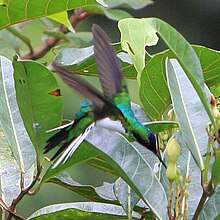Crimson Crown Jewelry Hummingbird
| Crimson Crown Jewelry Hummingbird | ||||||||||||
|---|---|---|---|---|---|---|---|---|---|---|---|---|

Crimson Hummingbird ♀ while breeding |
||||||||||||
| Systematics | ||||||||||||
|
||||||||||||
| Scientific name | ||||||||||||
| Heliothryx barroti | ||||||||||||
| ( Bourcier , 1843) |
The purple crown jewelery hummingbird ( Heliothryx barroti ) is a species of bird from the hummingbird family (Trochilidae). The species has a large range that extends from Mexico to Ecuador . The IUCN assesses the population as Least Concern .
features
The purple crown jewelry hummingbird reaches a body length of about 11.5 to 13 centimeters, with the short straight beak making up about 1.5 centimeters. The front upper head of the male glitters violet purple. The black eye mask ends in a thin, violet tuft of ears and is bordered below by a thin, glittering green stripe across the cheeks. The rest of the top is shimmering bright green while the entire bottom is white. In the long, graduated tail, the central control feathers are blackish, while the rest are white. The females are very similar but have a green skull and no green color on the cheeks. The central control feathers are a little shorter than in the male. In young birds , the top of the head, neck and parts of the underside are largely streaked with cinnamon stains. The throat and chest have only sparse dark spots.
behavior
This hummingbird is considered to be extremely active and rascal. It whizzes from flower to flower very quickly. They repeatedly open and close their tail feathers in flight. Occasionally they fly high to buzz provocatively in front of an observer and then quickly disappear again. They are often out and about on their own, looking for food from the ground to the treetops, but mostly in the middle and slightly higher strata in the forest or at the edges of the forest. Characteristic is the tail that is slanted while they are hovering, never clinging to flowers. Like the Mangocolibris ( Anthracothorax ) they fly relatively high to hunt insects. You never see them gathering nectar on trees in bloom. Occasionally they burrow into the flower base to collect nectar.
Reproduction
Their breeding season in Mexico is in March. Melbourne Armstrong Carriker observed three breeding females in the Departamento de Córdoba and in the north of the Departamento de Antioquia from April to May . In June, a nest was discovered in the valley of the Anchicayá River at an altitude of 550 meters. The nest is a fluffy calyx without lichen and moss. They build this at different heights near forest streams or at the edges of the forest.
Vocalizations
Usually they are quiet. From time to time they give off a tall, thin, slightly metallic sssit , which is then occasionally repeated in long, rapid succession.
habitat
Their habitat are moist to wet forests, forest edges and moist secondary vegetation. In Colombia, they are replaced by the black-eared hummingbird ( Heliothryx auritus ) in the east of the Andes . Here they move at altitudes between sea level and 1000 meters. Most of the time they can be found under 500 meters.
Etymology and history of research
Jules Bourcier described the purple crown jewelry hummingbird under the name Trochilus Barroti . The type specimen came from Cartagena in Colombia. It was not until 1831 that Friedrich Boie introduced the genus Heliothryx for several hummingbird species such as the black-eared hummingbird ( Heliothryx aurita ) ( Gmelin, JF , 1788), amethyst -eared hummingbird ( Colibri serrirostris ) ( Vieillot , 1816) (Syn: Trochilus petasophorus ( Wied-Neuwied , 1832) ) and the green-masked hummingbird ( Augastes scutatus ) ( Temminck , 1824). Only later was the purple crown jewelry hummingbird assigned to this genus. This name is derived from the Greek words "hēlios, ἡλιος " for "sun" and "thrix, trikhos, θριξ, τριχος " for "hair". The specific epithet is dedicated to the French diplomat Théodore Adolphe Barrot (1801–1870), who lived in Cartagena at the time. He had given the bellows to the Muséum national d'histoire naturelle .
literature
- Steve NG Howell, Sophie W. Webb: A Guide to the Birds of Mexico and Northern Central America . Oxford University Press, New York 1995, ISBN 978-0-19-854012-0 .
- Steven Leon Hilty , William Leroy Brown : A guide to the birds of Colombia . Princeton University Press, Princeton 1986, ISBN 978-0-691-08372-8 ( online [accessed March 9, 2015]).
- James A. Jobling: Helm Dictionary of Scientific Bird Names . Christopher Helm, London 2010, ISBN 978-1-4081-2501-4 .
- Friedrich Boie: Comments on species and some ornithological families and clans . In: Isis von Oken . tape 24 , 1831, pp. 538-548 ( online [accessed March 9, 2015]).
- Jules Bourcier: Oiseaux-mouches nouveaux ou mal connus . In: Revue Zoologique par La Société Cuvierienne . tape 6 , 1843, pp. 70-73 ( online [accessed March 9, 2015]).
Web links
- Heliothryx barroti inthe IUCN Red List of Threatened Species 2014.3. Listed by: BirdLife International, 2012. Retrieved March 9, 2015.
- BirdLife International: Species Factsheet - Purple-crowned Fairy ( Heliothryx barroti ) . Retrieved March 9, 2015.
- Videos, photos and sound recordings of Purple-crowned Fairy (Heliothryx barroti) in the Internet Bird Collection
- Crimson Crown Hummingbird ( Heliothryx barroti ) at Avibase; accessed on March 9, 2015.
- Heliothryx barroti in the Integrated Taxonomic Information System (ITIS)
- xeno-canto: Sound recordings - Purple-crowned Fairy ( Heliothryx barroti )


